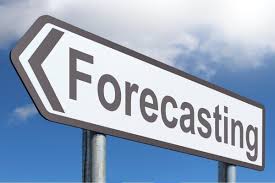
Forecasting refers to the practice of predicting what will happen in the future by taking into consideration events in the past and present. Basically, it is a decision-making tool that helps businesses cope with the impact of the future’s uncertainty by examining historical data and trends. It is a planning tool that enables businesses to chart their next moves and create budgets that will hopefully cover whatever uncertainties may occur.
How Forecasting Works
Investors utilize forecasting to determine if events affecting a company, such as sales expectations, will increase or decrease the price of shares in that company. Forecasting also provides an important benchmark for firms, which need a long-term perspective of operations.
Stock analysts use forecasting to extrapolate how trends, such as GDP or unemployment, will change in the coming quarter or year. The further out the forecast, the higher the chance that the estimate will be inaccurate. Finally, statisticians utilize forecasting in any situation that requires the use of forecasting. For instance, data may be collected regarding the impact of customer satisfaction by changing business hours or the productivity of employees upon changing certain work conditions.
Forecasting addresses a problem or set of data. Economists make assumptions regarding the situation being analyzed that must be established before the variables of the forecasting are determined. Based on the items determined, an appropriate data set is selected and used in the manipulation of information. The data is analyzed, and the forecast is determined. Finally, a verification period occurs where the forecast is compared to the actual results to establish a more accurate model for forecasting in the future.
Features of Forecasting
Here are some of the features of making a forecast:
1. Involves future events- Forecasts are created to predict the future, making them important for planning.
2. Based on past and present events- Forecasts are based on opinions, intuition, guesses, as well as on facts, figures, and other relevant data. All of the factors that go into creating a forecast reflect to some extent what happened with the business in the past and what is considered likely to occur in the future.
3. Uses forecasting techniques- Most businesses use the quantitative method, particularly in planning and budgeting.
The Process of Forecasting
Forecasters need to follow a careful process in order to yield accurate results. Here are some steps in the process:
1. Develop the basis of forecasting- The first step in the process is developing the basis of the investigation of the company’s condition and identifying where the business is currently positioned in the market.
2. Estimate the future operations of the business- Based on the investigation conducted during the first step, the second part of forecasting involves estimating the future conditions of the industry where the business operates and projecting and analyzing how the company will fare.
3. Regulate the forecast- This involves looking at different forecasts in the past and comparing them with the actual things that happened with the business. The differences in previous results and current forecasts are analyzed, and the reasons for the deviations are considered.
4. Review the process- Every step is checked, and refinements and modifications are made.
Sources of Data for Forecasting
1. Primary sources
Information from primary sources takes time to gather because it is first-hand information, also considered the most reliable and trustworthy sort of information. The forecaster himself does the collection, and may do so through things such as interviews, questionnaires, and focus groups.
2. Secondary sources
Secondary sources supply information that has been collected and published by other entities. An example of this type of information might be industry reports. As this information has already been compiled and analyzed, it makes the process quicker.
Budgeting vs Forecasting
One thing that is definitely true is that budgeting and forecasting are both tools that help businesses plan for their future. However, the two are distinctly different in many ways. Let’s consider the following points:
Budgeting involves creating a statement that consists of numerous financial activities of a company for a specific period, such as projected revenue, expenses, cash flow, and investments. It is usually not conducted solely by one department, say, the finance department, because it requires input from other departments in order to come up with a holistic and detailed report. Therefore, the budgeting process takes time to complete. The company uses the budget to guide it in its financial activities.
While budgets are usually made for an entire year, forecasts are usually updated monthly or quarterly. Through forecasting, a company is able to adjust its budget and allocate more funds to a department, as needed, depending on what is foreseen. In summary, budgets depend on the forecast.
Forecasting Methods
Quantitative method
Stock analysts use various forecasting methods to determine how a stock’s price will move in the future. They might look at revenue and compare it to economic indicators. Changes to financial or statistical data are observed to determine the relationship between multiple variables. These relationships may be based on the passage of time or the occurrence of specific events. For example, a sales forecast may be based upon a specific period (the passage of the next 12 months) or the occurrence of an event (the purchase of a competitor’s business).
Qualitative method
These models are useful in developing forecasts with a limited scope. These models are highly reliant on expert opinions and are most beneficial in the short term. Examples of qualitative forecasting models include market research, polls, and surveys that apply the Delphi method. Quantitative methods of forecasting exclude expert opinions and utilize statistical data based on quantitative information. Quantitative forecasting models include time series methods, discounting, analysis of leading or lagging indicators, and econometric modeling.
Financial and Business expert having 30+ Years of vast experience in running successful businesses and managing finance.






